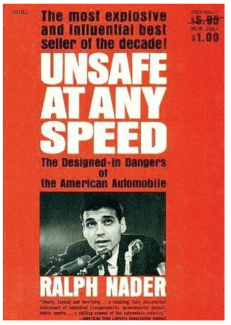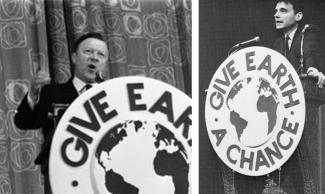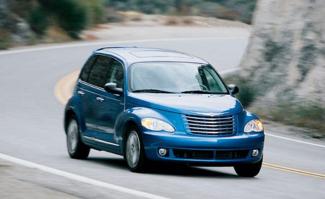One of 50 stories, from 50 years of action
by Elizabeth Harlow
When the Ecology Center published its original scientific findings on chemical hazards in auto interiors on HealthyCar.Org in 2006, “Toxic at Any Speed” marked the first ever consumer guide to toxic chemicals in cars. The unique research methodology and pioneering use of the web allowed a new level of public transparency about what “new car smell” meant and why it was (and still is) dangerous.
Over the life of the Healthy Cars project, the Ecology Center tested over 1,000 unique car models and yielded marketwide improvement in automotive chemical safety. All major U.S. auto manufacturers demonstrated a reduction in measured contaminants in car interiors as a result of our testing, which has also influenced international law, including recently announced new interior materials and air quality standards in the European Union and in Asia.
Auto Safety and Environmental Protection: Ann Arbor, 1970

When consumer advocate Ralph Nader published Unsafe at Any Speed: The Designed-In Dangers of the American Automobile in November 1965, the exposé rocked the public and the auto industry with its documentation of automobile designers’ neglect and resistance in implementing safety measures in cars. Inspired by Rachel Carson’s Silent Spring, which had ignited the environmental movement three years earlier, Unsafe at Any Speed became an unlikely hit on nonfiction bestseller lists. It also spurred the passage of seat belt laws in 49 states, prompted congressional hearings that led to the creation of the National Highway Traffic Safety Administration, and paved the road for future governmental involvement in automotive safety, among other consumer protection issues.
Cars were a major subject of conversation during the first Earth Day in 1970, especially here in Michigan, home to a full 40% of all U.S. auto industry workers at the time. Nader participated in Ann Arbor’s massive multi-day Teach-In for the Environment as a keynote speaker, and so did legendary labor leader Walter Reuther of the UAW, which donated $2,000 to support the event. Student organizers even staged a theatrical mock trial of a 1959 Ford sedan to indict the auto industry’s multifaceted role in generating pollution and injustice. Charged with “murder of the American public, crossing state lines to pollute, inciting traffic jams, creating physical and psychological dependence, and discriminating against the poor,” the car was sentenced to execution by sledgehammering, guilty on all counts.
Reuther called for a radical rethinking of the status quo to address what one Teach-In participant described as “ecological and social genocide”--a characterization that resonates today, starkly and differently, in light of the existential threat of unchecked climate change alongside massive rollbacks on fifty years of hard-fought laws to protect our air, water, and land. “We’ve got to create new instruments, new institutions,” Reuther said. “We’ve got to develop new approaches and new concepts to deal with these new problems.”

Seeking Safety for Fenceline Communities and Consumers
Walter Reuther knew that the people most affected by pollution are those on either side of factory fencelines: workers and neighbors. Rooted in this knowledge, the Ecology Center anchored our earliest auto industry work in a focus on helping manufacturing communities protect themselves from toxic chemicals.
When Jeff Gearhart began working at the Ecology Center in the 1990s, he joined forces with Ecology Center colleague Charles Griffith to launch the Great Lakes Automotive Pollution Prevention Network. The network focused on supporting grassroots organizing in communities with a significant auto industry presence. By providing environmental science expertise and organizing support to neighborhood groups and auto workers, he helped communities across the Great Lakes region advocate cleaner production, from plastic part suppliers to paint shops.
As Jeff worked, he and the Ecology Center environmental health team kept thinking about the environmental impact of a car across its full life cycle, from how it’s built to what happens after it gets scrapped for parts. From well before they roll off the assembly line to long after they leave the road, cars live lives that affect many people: today’s typical passenger vehicle contains 30,000 parts and drives 200,000 miles across 12 years.
The team started brainstorming ideas for how a small nonprofit could work to clean up not only the manufacturing process, but further aspects of the product itself. They asked two major questions. First, how can we identify, as comprehensively as possible, what substances a car is made of? Second, how can we use those answers to improve the health and safety of fenceline manufacturing communities, workers, car drivers and passengers, and those affected by chemicals in waste long after the driving is done?
In 2006, after half a year of thinking and of talking to industry experts, scientists, and funders, the Ecology Center developed an approach and secured resources, including a critical new tool: a handheld X-Ray Flourescence (XRF) device. The XRF gun could identify the elemental composition of any material in less than 60 seconds, without the need to remove a sample and send it to a lab for analysis. That tool allowed Ecology Center staff, and even trained student interns, to go to auto dealerships and scan new cars on the lot for toxic chemicals.
“We started out by asking drivers dropping off recyclables at the Recycle Ann Arbor Drop-Off station to participate in the study, because we weren’t initially sure how auto dealers would react to us when we showed up for data collection,” says Jeff. “Not everyone said yes, but the overwhelming majority did. It was of note how many car salespeople mentioned customers being concerned about the 'new car smell.' It turns out most are also used to visits from competitors’ engineers, auto suppliers, and other people trying to benchmark cars. Sometimes we’d be out there for four hours of testing, and we’d see other people there with calipers taking their measurements, too.”
Toxic at Any Speed
When the Ecology Center published its initial batch of results on chemical hazards in cars in 2006, the report nodded toward the previous history of the fight for automobile safety in its title: Toxic at Any Speed: Chemicals In Cars and the Need for Safe Alternatives. It was the first ever consumer guide to toxic chemicals in cars, offering transparency about what “new car smell” meant and what kinds of health risk it signaled in specific vehicles.

Toxic at Any Speed ranked over 200 different new cars for environmental safety based on the chemicals found in places most likely to contribute to passenger exposure. It identified bromine, chlorine, lead, and other substances known to be carcinogens, allergens, and endocrine disruptors in seat cushions, arm rests, floor coverings, steering wheels, instrument panels, and other interior components.
The report was groundbreaking, both in its findings and in strategic approach. Not only did the Ecology Center pioneer a new application of high-speed, low cost XRF technology in nonprofit science, it also used the internet to promote transparency and community empowerment, bringing grassroots science from the print world to the digital world on HealthyCar.org. The website was so unexpectedly popular that the initially small Ecology Center server crashed multiple times from the weight of concerned consumer traffic.
That report and follow up studies, all shared publicly on HealthyCar.org and later on HealthyStuff.org, received national media coverage from nearly every major TV network and a raft of news publications, including CNN, NBC, CBS, ABC, Fox, Telemundo, the New York Times, Consumer Affairs, and--notably for industry insiders--the Detroit Free Press. The Free Press coverage was featured during the week of the annual Detroit Auto Show, one of the world’s largest auto shows and a high-profile venue for manufacturers to debut new products.
Automakers Respond
Major car manufacturers paid attention to the scrutiny they received from media and from customers who demanded safer vehicles, and they responded to the Ecology Center’s research and advocacy with increased attention to indoor air quality and the materials they were using in their cars.
By 2012, the Ecology Center was able to chart significant improvements across the auto industry, especially on the use of hazardous heavy metals, brominated flame retardants, and phthalate-laced PVC plastic. “The best vehicles today have eliminated hazardous flame retardants and PVC” that year’s report summary noted, adding that “17% of new vehicles have PVC-free interiors and 60% are produced without BFRs.” Honda and Toyota led the pack on overall performance with the Civic and the Prius, while Volkswagen, Mitsubishi, and Ford were ranked most improved makers, showing between 30-40% reductions in detected chemicals of primary concern across models tested.
In a 2012 video, Ecology Center and auto industry experts discuss toxic chemicals in cars
Over the life of the Healthy Cars project, the Ecology Center tested over 1,000 unique car models and yielded marketwide improvement in automotive chemical safety. All major U.S. auto manufacturers demonstrated a reduction in measured contaminants in car interiors as a result of our testing. In response to our pressure, many also began conducting their own toxic chemical testing, started demanding changes from their suppliers, and improved voluntary reporting on progress to remove chemicals of concern from their supply chains. "We're pleased to be recognized by HealthyStuff.org for our efforts,” said Marcos Frommer, Manager of Corporate Affairs & Communications at American Honda, about Honda’s high ratings in the 2012 Healthy Cars report.
The Future of Automotive Chemical Safety: Making “New Car Smell” Illegal
Globally, the Ecology Center’s work has spurred new interior materials and air quality standards in the European Union and Asia, which have resulted in 2020 headlines declaring that “New Car Smell May Soon Be Illegal.”
Fourteen years after the debut of HealthyCar.org, the Ecology Center remains an influential expert voice for consumers on chemical hazards that persist in cars, which include toxic flame retardants and PFAS both in vehicles and in essential vehicle accessories like children’s car seats. The Ecology Center has annually tested car seats for toxic chemicals since 2007, prompting manufacturers to introduce 16 chemically-safer models where there were none just four years ago. Seeking long-term policy solutions that go beyond market options, the Ecology Center actively advocates improved federal flammability standards for vehicles and vehicle accessories. Jeff Gearhart also continues to conduct health and safety training for UAW workers on chemical hazards, alternative assessment, and safer material substitution.
The driving interest that led to the creation of HealthyCar.org in 2006, in addressing the full lifecycle of a car as a consumer product, became the jumping off point for some of the Ecology Center’s most significant work today, auto-related and otherwise. Healthy Cars kicked off consumer product chemical safety work that has extended well beyond the automotive industry: Healthy Stuff today documents test results for chemicals of concern in over 15,000 products and counting, and the fight continues for scientific knowledge and comprehensive chemical policy to make our cars and other products safe for people and planet, at any speed.
What's that Smell?
Research for these stories provided by the Environmental Justice HistoryLab at the University of Michigan. For more details, check out our history archive.


